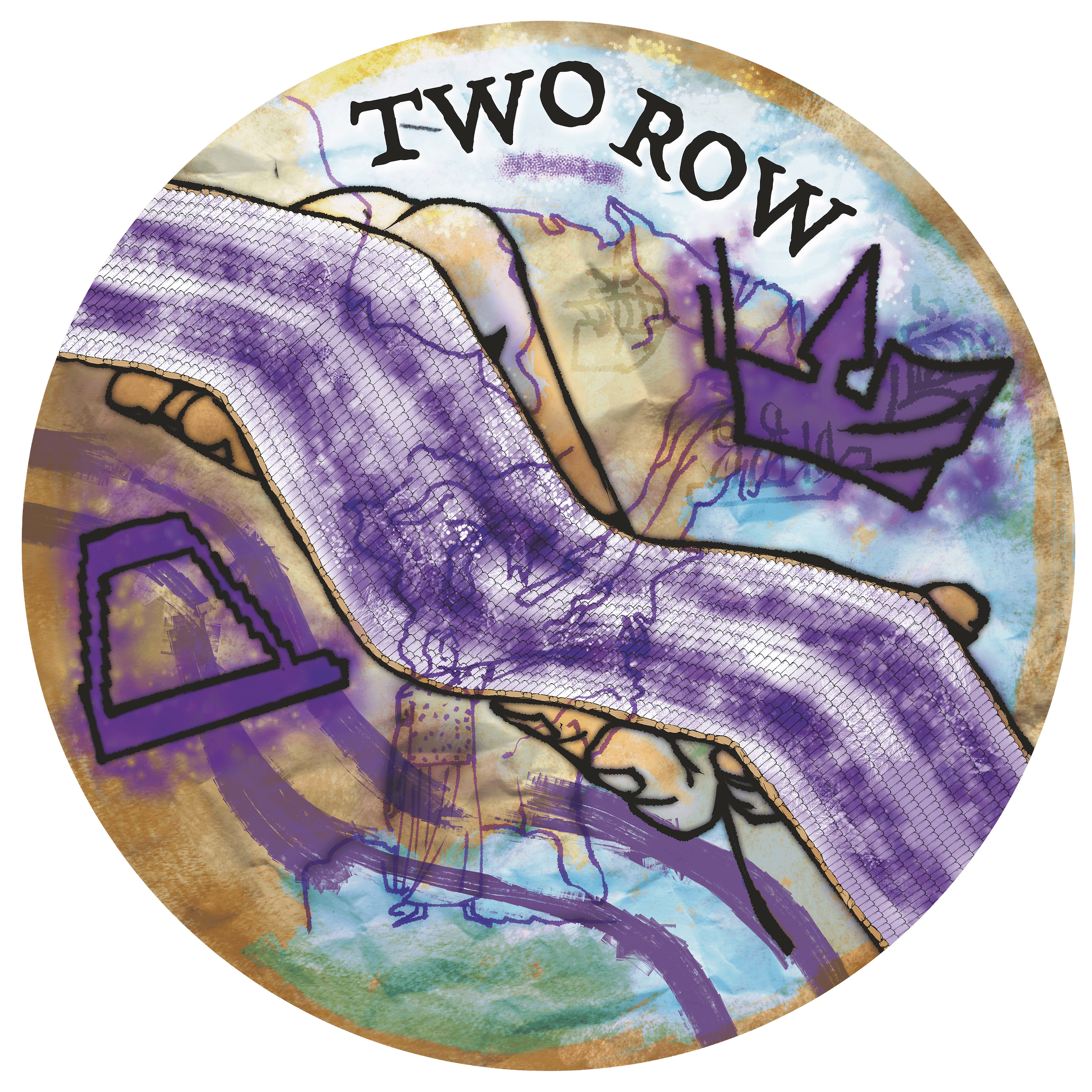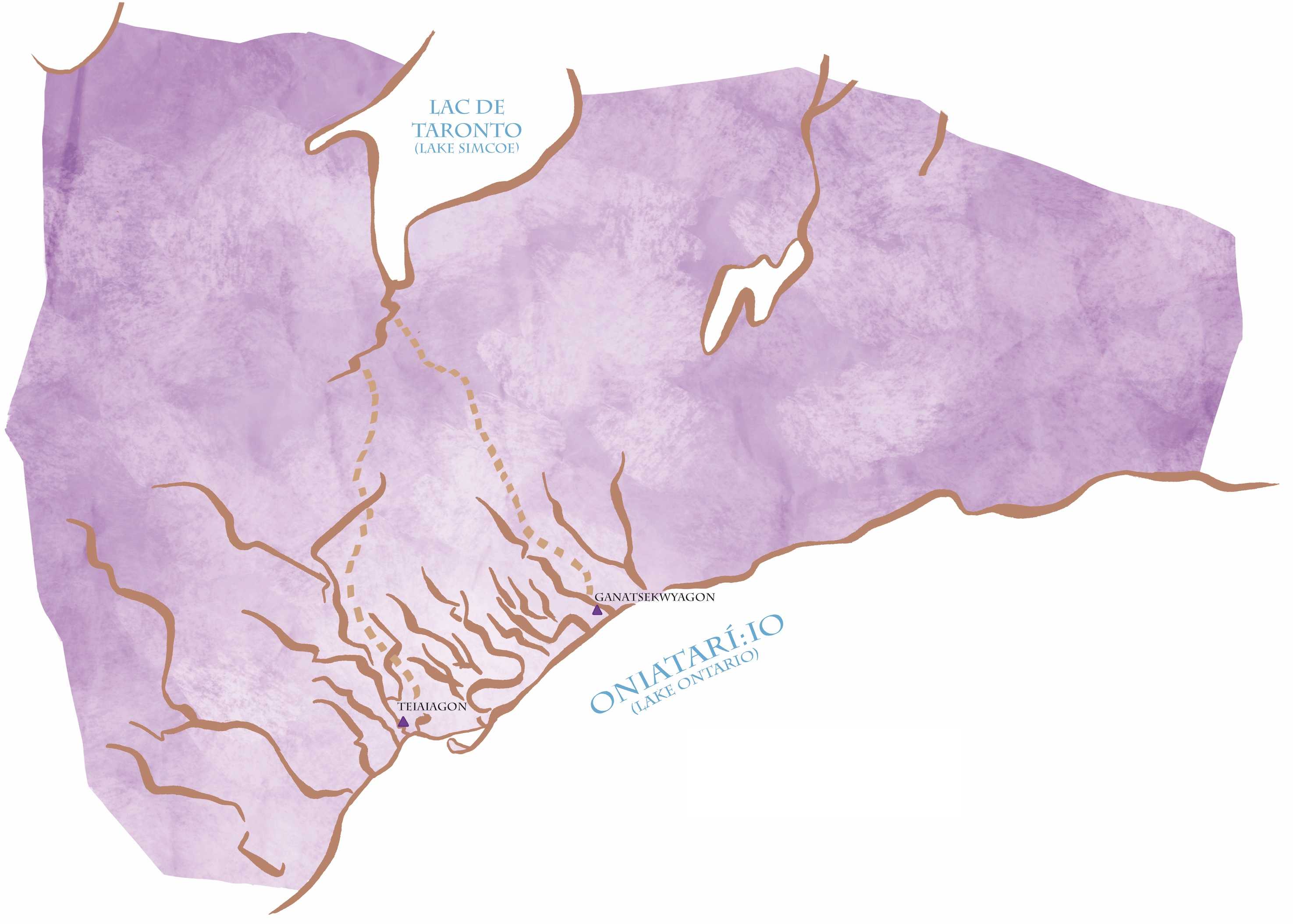The Two Row Wampum, ca. 1613

In the early 1600s, the Mohawk develop an alliance with the Dutch in the territory the Dutch claim as New Netherland (New York State and beyond). They conclude an agreement to live peacefully as allies in developing fair trade along the Hudson River, the strategic north-south corridor between New Amsterdam (Manhattan) and New France. This agreement is codified in the Tekhni: Teyoh:teʔ Kaswentha (Two Row/Path Wampum Belt), which contains both the philosophy and imagery of treaty making, from a Haudenosaunee point of view. To ensure safe passage and noninterference for both partners, rules are put in place.
Each nation will travel side by side, along the river of life, in their own vessels – the Dutch in their ship, the Mohawk in their canoe. Neither party will attempt to “steer” the vessel of the other.
Now we have laid our vessels out, parallel to each other, so too it is with our beliefs,” states the Haudenosaunee Oral History of the Tekhni: Teyoh:teʔ Kaswentha. As the Mohawk speaker states, “My beliefs will be in my canoe, yours will be in your boat. I will also put my laws in my canoe, and you will put your laws in your boat. Our authority, beliefs and laws will be dropped into our vessels. That is how people will know it, by the likeness to two paths.
Thus, the imagery of a Dutch ship with large sails, floating alongside a bark canoe is born. The wakes of those vessels create the two rows of the Wampum Belt, two parallel bands of dark purple beads symbolizing a separate-but-equal relationship. The two nations are bonded together by a three-link chain: the first link is friendship; the second, good minds; the third, perpetual peace.
The Tekhni: Teyoh:teʔ Kaswentha is an ongoing agreement to coexist independently and is the foundation for all subsequent Haudenosaunee treaties with European nations. It is grounded in the Kanianerenko:wa, or Great Law of Peace, and extends its principles of Sgënö’ (Peace), Ga’hasdehsäh (Strength through Unity), and Ga’nigoi:yoh (Good Mind and Equal Justice) to the newcomers.

PURPLE WAMPUM
Denotes drama, conflict
By 1649, parties of Seneca and Mohawk head north, likely using Toronto-area portage routes, to attack the Wendat Confederacy in Wendake. The Wendat and Tionontaté/Petun Confederacies in Wendake, already massively weakened by epidemics, splinter, their populations decimated and scattered across the region. The Haudenosaunee continue pushing north. They drive out the Anishninaabek along the north shore of Georgian Bay. Some Wendat join their Anishinaabe allies and move to more northwestern Anishnaabe Territories, while others establish a village near the settlement of Quebec with the support of their French allies.
Roughly half of the surviving Wendat, and even more Tionontaté and Attawandaron, are adopted into Haudenosaunee communities. Some individuals and entire Clans choose to join their culturally similar relatives; others are captured and incorporated against their will. One group of Wendat and Tionontaté moves south to the Detroit area and becomes known as the Wyandot (many are later forced to move farther west, to present-day Oklahoma and Kansas). By 1700, nearly two-thirds of the Haudenosaunee will be adoptees. Adoption helps to offset severe population losses incurred through warfare and epidemic diseases.
The Seneca Nation claims the former Wendat Territories and their role in the regional fur trade. They establish two villages on the north shore of Lake Ontario, Teiaiagon, on the Humber, and Ganatsekwyagon, on the Rouge River, which gives them control over the two portage routes to the upper Great Lakes. Because they also control Lake Ontario, they are able to divert regional furs from the French at Montreal to the Dutch in New Netherland.

THE SENECA IN TORONTO (C. 1660-1695)
After the dispersal of the Wendat in 1650, the Seneca take over the Wendat fur trade and their hunting territory in the Toronto area, establishing villages in the Toronto area as part of a network of new villages across the north shore. Extended families live together in large Longhouses, with a mother or grandmother in charge of daily operations. Membership and lineage are passed on through the mother’s Clan. Planting plots are also divided by Clan. All agricultural affairs are managed by the women.

Clan mothers select the male leadership from within their Clan. They can unseat those who do not effectively serve their communities. Each Clan has its own Clan Council. Two Councils – one focused on civil jurisdiction, the other on war – govern village affairs. Any individual can raise an issue for consideration to the Village Council, which can pass laws. Issues can then be brought forward from Village Councils to the Nation’s Council. Each nation has territory, sovereign status, and decision- making ability for its own people. Decisions are made by consensus. Seneca villages on the Rouge and Humber have their own Village Councils. They likely attend Seneca Nation and Haudenosaunee Confederacy Councils south of Lake Ontario.
From the 1660s to at least the late 1680s, the villages of Teiaiagon and Ganatsekwyagon control the portage routes that bring the rich furs of the north to Lake Ontario. From there, the Seneca can route furs either to the French in Montreal or follow the path from Toronto to Albany, crossing Lake Ontario and following the Hudson River south, through friendly Haudenosaunee Territory. This threatens France’s monopoly of access to the furs of the upper Great Lakes and hence the economy of New France.
As Dutch and English fur traders visit Teiaiagon and Ganatsekwyagon, the French must keep up with the trade offerings of their colonial competitors at Albany and are forced to lower prices. In 1673, the French establish the military and trading post of Fort Frontenac, at Cataraqui (Kingston), in an attempt to block this trade. Because New France needs to maintain the alliances necessary for defence against the growing threat of the English colonies (which have ten times the population of New France), France begins to subsidize its fur trade, paying traders to trade with Indigenous Peoples at a loss. French traders also trade at Teiaiagon.
